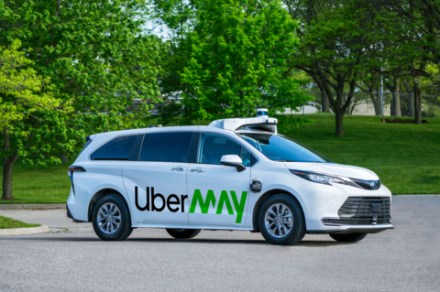Self-driving racing is in high gear and Uber has just added more horsepower. Uber and autonomous vehicle company May Mobility have announced a multi-year partnership that will see driverless rides available in Arlington, Texas, by the end 2025. Thousands more vehicles are planned for the U.S. over the next few years.
Uber has taken significant steps to make autonomous ride-hailing an option for the general public. The company already works closely with Waymo whose robotaxis can be seen in multiple cities. May Mobility is pleased to welcome hybrid-electric Toyota Sienna vans to its platform. The vehicles will initially be driven by safety drivers, but as deployments progress, they are expected to become fully autonomous.
This is not a new game for May Mobility. It’s been providing AV services to geofenced areas, backed by Toyota, BMW and other major players since 2021. Its AI-powered Multi-Policy Decision Making (MPDM) tech allows it to react quickly and safely to unpredictable real-world conditions–something that’s helped it earn trust in city partnerships across the U.S. and Japan.
The expansion of ride-hailing services is part and parcel of a larger industry trend. Waymo is widely regarded as the current leader in AV and continues to expand its service into cities such as Phoenix and Austin. Tesla, meanwhile is preparing to launch a robotaxis in Austin, Texas this June with a small number of Model Ys powered using its camera-based full self-driving system (FSD). While Tesla is aiming for affordability and scale deployments, Waymo, May, and other companies are focused on safety first deployments, using sensor-rich technologies, including lidar, a tech stack that regulators have favored so far.
Beyond the ride-hailing industry, the idea of owning a self-driving car is also gaining popularity. Waymo and Toyota announced recently that they are exploring ways to bring full autonomy to personal vehicles. This could bring robotaxi technology right into your garage.
With the likes of Uber, Tesla and Waymo in the mix, ride-hailing is changing fast. The road ahead appears to be increasingly driver-free.
Nick Godt has covered global business news on three continents for over 25 years.
You may have to wait longer for a more affordable Tesla Model Y
It’s been a while since Tesla gave a long-awaited makeover to its Model 3 EV, and followed it with the introduction of an updated Model Y in its home market. However, the company’s rumored plans for a more affordable SUV that will be assembled in the US have reportedly run into a delay.
According to Reuters, Tesla was hoping to assemble nearly a quarter million units of its cheaper Model Y variant in 2026. The goalpost has now been shifted, and there is no clarity regarding a revised market launch plans for the vehicle, which is said to be in development under the codename E41. .
Samsung looks to iPad technology for its new automotive OLED displays
According industry sources, Samsung Display reportedly wants to adapt technology similar that is used in Apple’s iPad display for implementation in automotive OLED displays. This strategic move shows Samsung’s continued push to the high-end vehicle display market.
Technology cross-over
Read More
Mercedes Vision V concept proves that luxury vans are an excellent idea
Now, the automaker wants to apply this expertise to a completely different form factor.
Mercedes will launch a new van generation that is also its first designed from the ground-up for electric powertrains while still performing all the functions of its existing van lineup. Mercedes will introduce the new vans before they show off the daily delivery vehicles and shuttles for hotels. The Vision V is a concept car that shows how luxurious a van could be.
Read More


